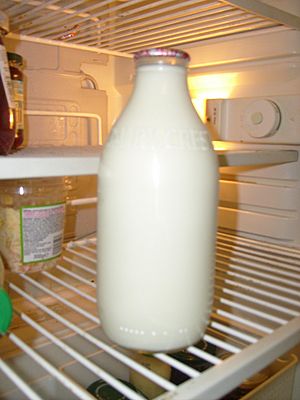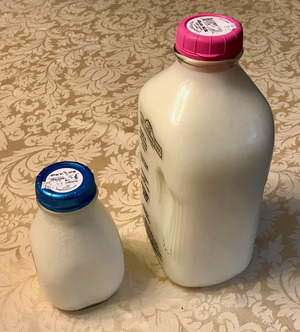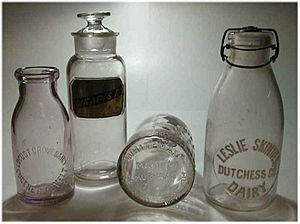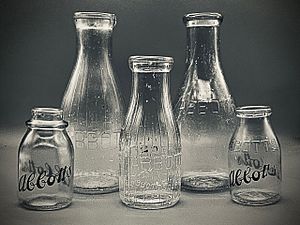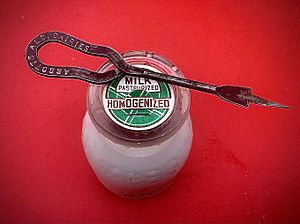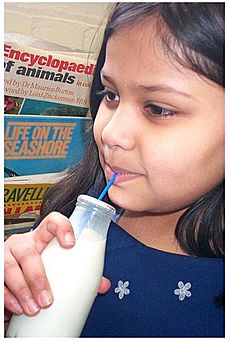Glass milk bottle facts for kids
Glass milk bottles are special glass bottles used to hold milk. They are usually designed to be used many times. After you finish the milk, you are expected to rinse the bottle. Then you can leave it out for the milkman to collect. Sometimes, you can also return them to a store.
Milk bottles are mostly used for milk delivered right to your doorstep. You might also find them for sale in stores in some places. These stores often ask for a small deposit when you buy the bottle. This deposit encourages people to return the empty bottles. The size of milk bottles can be different depending on where you are. Common sizes include a pint, quart, or litre.
More recently, plastic bottles have become very common for milk. These are often made from a type of plastic called high-density polyethylene (HDPE). Unlike glass bottles, plastic ones are usually used only once. However, they are easy to recycle. Other types of plastic containers are also used for milk.
Contents
The History of Milk Bottles
Before milk bottles existed, milkmen would pour milk directly into jugs that customers brought out. For many collectors, old milk bottles bring back memories of a time gone by. The most valuable milk bottles have names of dairies pressed into the glass or painted on them. This helped make sure the bottles found their way back to the correct dairy after being used.
It is not fully clear when the very first milk bottles were used. From the 1860s to the 1890s, people experimented with different "jars" for milk. These early jars were not patented, but they were still used. One example is the Tuthill Milk Company jar, which had a rough lip and a special base. In 1878, George Henry Lester received the first patent for a glass jar made to hold milk. This jar had a glass lid held on by a metal clamp. In the same year, a milk seller from Brooklyn named Alex Campbell started selling milk in experimental glass bottles. These bottles probably looked different from the milk bottles we know today.
Lewis P. Whiteman held the first patent for a glass milk bottle with a small glass lid and a tin clip. His brother, Abram V. Whiteman, received the next patent on September 23, 1884. This patent was for a milk bottle with a dome-shaped tin cap. The Whiteman brothers made these bottles at the Warren Glass Works Company in Cumberland, Maryland. They sold them through their office in New York.
The "Original Thatcher" bottle is very popular among collectors. Its glass dome lid was patented on April 27, 1886. There are many different versions of this early milk bottle, and also many copies. During this time, many kinds of bottles were used for milk. This included bottles that looked like pop bottles with a wire clamp. Even fruit jars were sometimes used, but only the Cohansey Glass Manufacturing plant put dairy names on them.
Around 1900, the Thatcher Manufacturing Company created the "Commonsense Milk Bottle." This bottle had the first "cap seat," which was a special rim for sealing the bottle. This design made it cheaper to seal reusable milk bottles. Most bottles made after this time have a cap seat.
By the 1920s, glass milk bottles had become standard in the United Kingdom. They were slowly introduced from the United States before World War I.
Milk bottles made before the 1930s were usually round. In 1935, bottles with slender necks were introduced in the UK. By the 1940s, a square, squat (short and wide) bottle became more popular. Since the 1930s, dairies have used a method called "pyroglaze" or ACL (Applied Color Label) to put names and designs on bottles. Before the 1930s, names were pressed into the glass using a "slug plate." This plate was inserted into the mold when the bottle was made. In 1980, a new bottle, called "dumpy," was introduced in the UK. It is still the standard bottle there today.
During the Second World War, it became illegal to misuse or hoard milk bottles in the United Kingdom. About 2.5 million bottles were saved during this time. A company called Milk Vessels Recovery Limited was started in 1920. Their job was to recover aluminum bottle tops.
In the United States, starting in the 1960s, glass bottles were mostly replaced. This happened because shipping and storage materials improved. Milk began to be sold in paper cartons coated with plastic or in recyclable plastic containers. These paper and plastic containers are lighter, cheaper, and safer to make and ship.
In 1975, 94% of milk in the UK was sold in glass bottles. However, by 2012, this number had dropped to only 4%.
Some people in America are now concerned about the quality of milk from large factories. Because of this, local milk industries that sell non-homogenized milk have become popular again. This has led to more glass bottles being used for local milk delivery.
Key Moments in Milk Bottle History
- 1880 – The Express Dairy Company in the United Kingdom produced the first British milk bottles. These were delivered by horse-drawn carts. The first bottles had a porcelain stopper held on by wire. Lewis Whiteman patented a glass milk bottle with a glass lid.
- 1884 – Dr. Thatcher invented a glass milk container in New York. These were first sealed with wooden plugs, but these did not work well. They were soon replaced by glass stoppers.
- 1894 – Anthony Hailwood developed the milk pasteurisation process. This made sterilized milk that could be stored safely for longer.
- 1920 – Advertisements started appearing on milk bottles. They were etched onto the glass using a sand-blasting method.
- 1930s – More and more battery electric vehicles, called milk floats, were used for milk delivery.
- mid-1950s – Paperboard tops were thought to be unhygienic and were banned in some places. Delivery by horse-drawn carts was still common.
- early-1990s – Advertising on bottles mostly disappeared. This was because new scanners were used to check how clean the bottles were.
Milk Bottles Today
In some parts of the world, the color of the tops on milk bottles tells you about the fat content. For example, unpasteurized milk often has a green top. However, different dairies might use different color codes. Bottles might also have the dairy's name stamped or pressed into them.
In the United Kingdom, the aluminum foil tops on glass milk bottles usually have these colors:
| Colour | What it means | |
|---|---|---|
| Gold | Channel Island milk (very rich milk) | |
| Silver | Whole milk (not homogenized, meaning the cream might separate) | |
| Red | Homogenized whole milk (cream is mixed in evenly) | |
| Red & Silver stripe | Semi-skimmed milk (some fat removed) | |
| Dark Blue & Silver stripe | Skimmed milk (most fat removed) | |
| Orange | 1% Fat milk | |
In the past, other colors were used. For example, pink was for milk processed at very high temperatures (UHT milk). Blue was used for "sterilized" milk.
Modern dairies might also use plastic bottles that can be refilled. The color codes for plastic milk bottle tops can be different from glass bottles. In the United Kingdom, the plastic tops on plastic milk bottles are usually colored like this:
| Colour | What it means | |
|---|---|---|
| Gold | Channel Island milk | |
| Blue | Homogenized whole milk | |
| Green | Semi-skimmed milk | |
| Red | Skimmed milk | |
| Orange | 1% Fat milk | |
In the United Kingdom, milk delivered to homes is mostly measured in Imperial pints. Even though it's labeled 568ml, it's still called a pint. This is because glass bottles are "returnable," so they were not changed to metric sizes. However, sterilized milk delivered to homes comes in 500ml glass bottles. These are "non-returnable" and have color-coded lids that match plastic bottles. In supermarkets, milk is often sold in pints but labeled with its metric size (568ml). Larger amounts than a pint are usually sold in metric units or multiples of a pint.
In Hong Kong, milk is sold in glass and plastic bottles, as well as in cartons. Glass milk bottles are found in supermarkets, convenience stores, and small restaurants. There is a deposit of 1 Hong Kong dollar for glass milk bottles. Two common brands that use glass bottles are Kowloon Dairy and Trappist Dairy. They both have different shaped glass milk bottles, including a size often used in schools.
Orange juice and other fruit juices are also delivered to doorsteps in the same style of bottle as milk. These usually have an aluminum foil top with a color that shows the flavor.
In some countries, like Estonia and parts of Canada, it is common to buy milk in a milk bag. While not very common in the United Kingdom, some supermarkets and delivery services do sell semi-skimmed and skimmed milk in bags.
School Milk Bottles
Small glass milk bottles, holding about a third of a pint, were created in the United Kingdom in the mid-20th century. Their purpose was to provide milk to children attending primary school. In the early 1970s, these bottles were the most common way to package school milk. However, they have slowly been replaced by third-pint cartons and plastic bottles.
Leicester, South Tyneside, Leeds, and Kirklees were the last areas where school milk was still given in glass bottles. This continued until dairies stopped using them in 2007. Children usually drank their milk using a straw pushed through the aluminum foil cap. They did not usually pour the milk into a cup.
See also
 In Spanish: Botella de leche de vidrio para niños
In Spanish: Botella de leche de vidrio para niños


